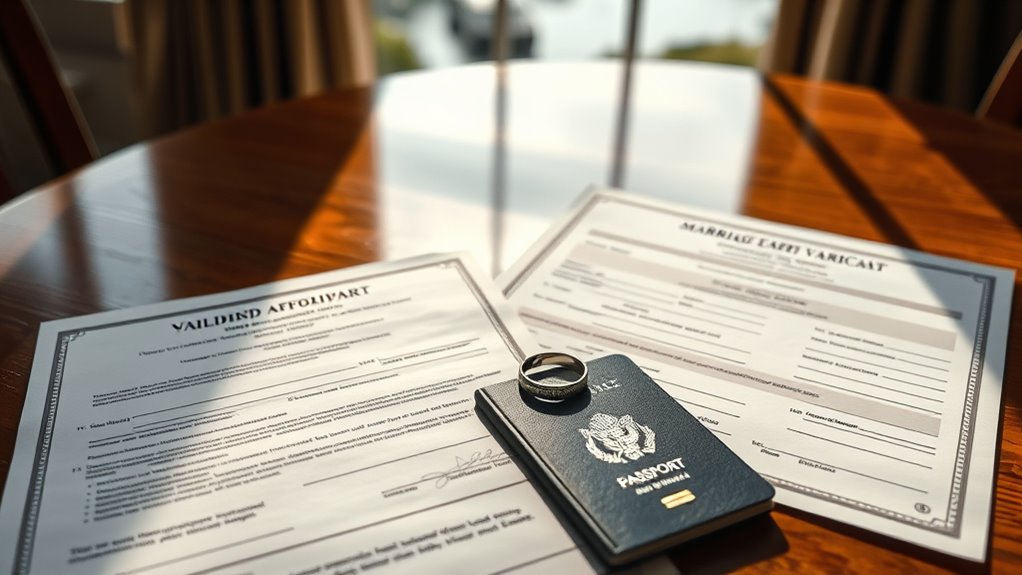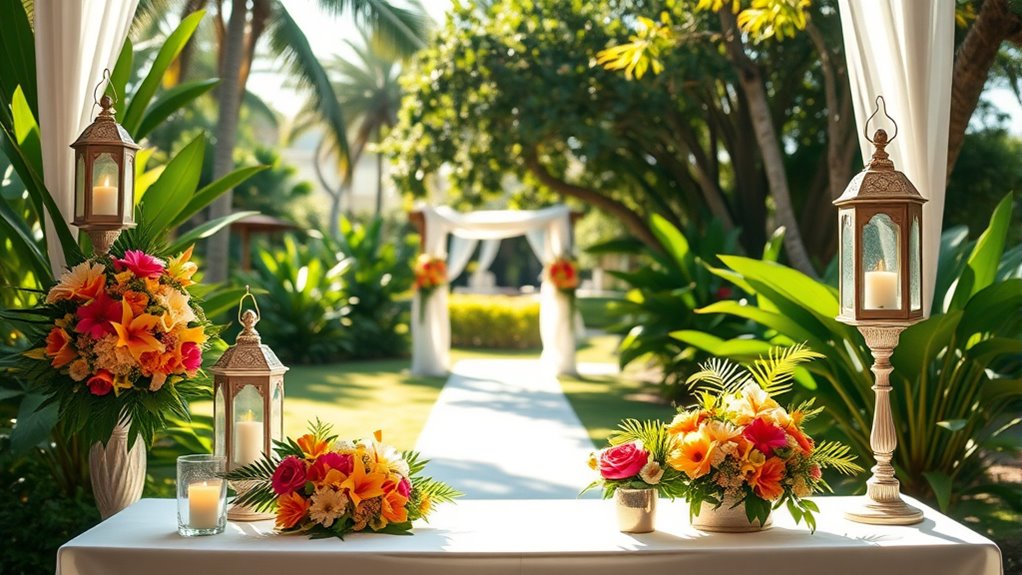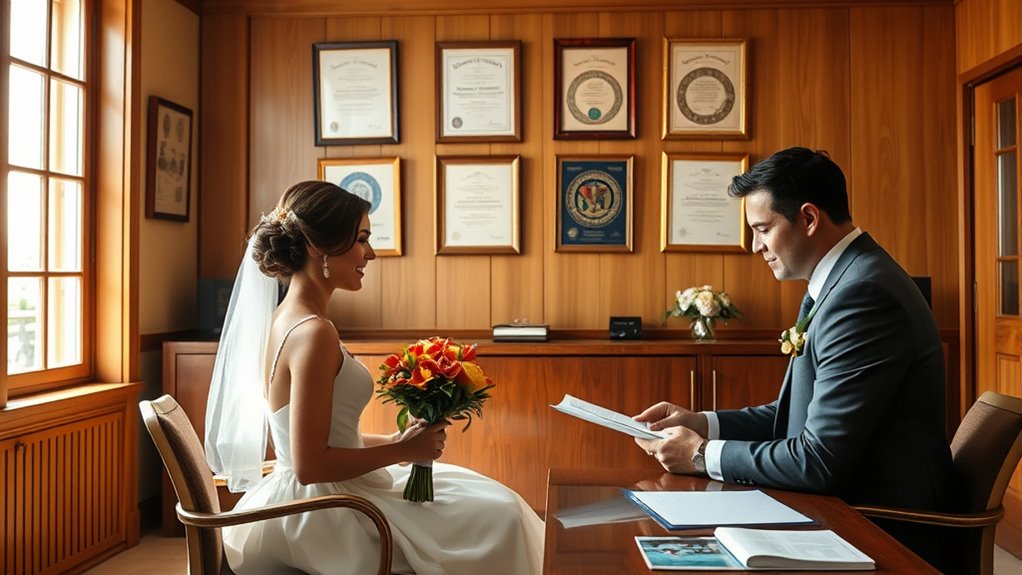To marry a Filipina, you’ll need to meet legal age requirements, obtain parental consent if necessary, and verify your legal capacity to marry. Gather essential documents like your birth certificate, passport, and a Certificate of No Marriage Record. Complete the marriage license application with your local civil registrar. Don’t forget to choose a ceremony type and meet officiant requirements. There’s more to know to guarantee everything goes smoothly, so keep exploring!
Key Takeaways
- Verify your legal capacity to marry by obtaining a “Certificate of Legal Capacity to Contract Marriage” from your embassy, if you’re a foreigner.
- Gather required documents, including a Certificate of No Marriage Record (CENOMAR) and birth certificates for both parties.
- Complete the Marriage License Application Form and prepare necessary photocopies of identification and supporting documents for submission.
- Schedule an appointment with the local civil registrar, submit the documents, and pay applicable fees to obtain the marriage license.
- Ensure compliance with local marriage laws and plan the wedding ceremony, considering any cultural or religious requirements.
Understanding the Legal Age Requirements

When you’re considering marrying a Filipina, it’s essential to understand the legal age requirements that apply.
In the Philippines, the minimum legal age for marriage is 18 years old for both males and females. If you or your partner is under 18, you can’t marry, even with parental consent.
For those under 21, obtaining parental consent is mandatory to proceed with marriage. While individuals aged 21 to 25 need parental advice, this doesn’t invalidate a marriage if absent, but it may delay your marriage license.
The Family Code of the Philippines lays out these requirements to guarantee legal adulthood and protection against early marriage, aligning with international standards.
Make certain to comply with these laws to guarantee your marriage is legally recognized.
Verifying Legal Capacity to Marry

After confirming the legal age requirements, the next step involves verifying your legal capacity to marry.
As a foreigner, you’ll need to obtain a “Certificate of Legal Capacity to Contract Marriage” from your embassy in the Philippines. This certificate confirms that no legal impediments exist for your marriage.
If you’re from the U.S., note that you can’t use substitute documents; the embassy must issue the certificate. To apply, gather required documents like your valid passport, proof of registration, and an official birth certificate.
You may also need to appear in person and guarantee all documents are authenticated. This process guarantees compliance with Philippine marriage laws and helps you smoothly navigate your marriage application.
Obtaining Proof of Single Status

To marry a Filipina, you must obtain proof of your single status, which is essential for your marriage application.
Start by securing a Certificate of No Marriage Record (CENOMAR) from the Philippine Statistics Authority (PSA). This document verifies you have no existing marriage records.
If you’ve never been married, consider drafting an Affidavit of Singleness, which needs a notary public’s oath. Alternatively, a local civil registrar can provide a Certificate of Singleness.
If you’ve been married before, gather the necessary annulment decree or divorce documents.
Always keep copies of your birth certificate and any relevant legal documents. Confirm your documents are current, and consult local authorities or legal experts if you’re unsure about the process.
Securing Parental Consent for Minors

Securing parental consent is essential if you’re between 18 and 21 years old and planning to marry a Filipina. Under Article 14 of the Family Code of the Philippines, you need this consent in writing, signed before a competent official like a notary public or civil registrar.
Your parents must express their consent clearly, including their names and yours, and two witnesses must attest to it. If a parent is deceased, the surviving parent or legal guardian can provide consent.
Once you have the document, submit it to the Local Civil Registry Office along with your marriage license application. Remember, without proper consent, your marriage could be deemed voidable, so take this step seriously.
Completing Required Documentations

Completing the necessary documentation for marrying a Filipina can feel overwhelming, but it’s essential for ensuring a smooth process.
Start with the Marriage License Application Form, filling out four copies in front of a consular officer. You’ll need one original and three photocopies of your PSA birth certificate with an Apostille from the DFA.
Don’t forget to provide four photocopies of your valid Philippine passport data page and obtain a Certificate of No Marriage (CENOMAR). This document costs around Php 420.
A Community Tax Certificate (Cedula) is also required. Make sure all documents are verified, and keep multiple copies for your records.
Stay updated on any changes in requirements by checking with the DFA or relevant embassies.
Navigating the Pre-Marriage Process

While preparing to marry a Filipina, it’s essential to understand the pre-marriage process, which involves several legal requirements and steps to guarantee everything goes smoothly.
First, you must apply for a marriage license at the local civil registrar where either of you resides; it’s valid for 120 days. If you’re a foreigner, get an affidavit from your embassy as a Certificate of Legal Capacity to Marry.
You’ll also need to undergo mandatory pre-marital counseling from certified providers. Additionally, make certain you have a Certificate of No Marriage (CENOMAR) if you’re marrying a Filipina.
Don’t forget to budget for government fees and consider the community’s posting period for the marriage license to allow for public notice.
Choosing Your Marriage Ceremony Type

When deciding on the type of marriage ceremony, you have several options that can reflect your personal beliefs and cultural traditions.
You might choose a religious ceremony, often held in a Catholic church, featuring traditional rituals like the exchange of vows, rings, and symbolic items such as the veil, cord, and coins.
Alternatively, a civil ceremony offers a legal and non-denominational option performed by a government official.
If you belong to the Muslim faith, consider a Nikah ceremony followed by a Walima reception.
For those blending traditions, interfaith ceremonies incorporate elements from different religions, while secular ceremonies focus on personal vows without religious ties.
Each choice allows you to honor your unique relationship.
Meeting Officiant Requirements

To guarantee your marriage ceremony proceeds smoothly, you need to meet the officiant requirements set by Philippine law.
Authorized officiants include judicial figures, such as judges, and public officials like mayors. Religious leaders, including priests and ministers, can also officiate if registered with the local civil registrar.
In special circumstances, military commanders, ship captains, or airplane chiefs may conduct weddings, particularly when there’s imminent danger of death. If you’re marrying abroad, consular officials can officiate for Filipino citizens.
Verify your chosen officiant has the necessary Certification of Registration of Authority to Solemnize Marriage and that all legal documents are in order.
This preparation guarantees your ceremony is valid and recognized by law.
Post-Ceremony Registration Steps

After your wedding ceremony, it’s vital to follow the necessary post-ceremony registration steps to guarantee your marriage is officially recognized.
The solemnizing officer, whether a judge or priest, must submit your signed marriage certificate to the local civil registrar within 15 days for civil weddings or 30 days for religious ones.
Once submitted, the local civil registrar records your marriage in its registry and sends the information to the Philippine Statistics Authority (PSA).
You can later request a PSA-certified copy of your marriage certificate through various channels, which is important for updating personal records or applying for spousal visas.
Additional Considerations for Foreign Nationals

Maneuvering the legal landscape of marrying a Filipina can be complex, especially for foreign nationals. You’ll need a Certificate of No Impediment from your home country, confirming no legal barriers to your marriage.
Additionally, provide an original or certified copy of your birth certificate, and if applicable, a divorce decree or death certificate from previous marriages. Submit these documents to your embassy in the Philippines to obtain a Certificate of Legal Capacity to Marry.
When applying for a marriage license at the local civil registrar, both of you must be present with all documents.
Frequently Asked Questions
What Are the Costs Associated With Getting Married in the Philippines?
When you’re planning to get married in the Philippines, expect various costs. Venue rental, wedding planner fees, and marriage license expenses can add up quickly.
For a civil wedding, judge fees usually start at ₱8,000, while church ceremonies typically range from ₱6,000 to ₱15,000.
Don’t forget about food, decorations, and photography, which can greatly impact your budget.
Always factor in travel and accommodation if you’re bringing guests or coming from abroad.
How Long Does It Take to Process a Marriage License?
Processing a marriage license is like waiting for a flower to bloom; it takes time and care.
After you file your application, you’ll need to endure a ten-day waiting period, typically counted in calendar days.
However, gathering necessary documents can stretch this timeline.
Local variations might also add a twist, so keep your eyes peeled for specific requirements in your municipality.
Patience is key as you navigate this important step toward marriage.
Can I Marry a Filipina if I’M Not a Resident?
Yes, you can marry a Filipina even if you’re not a resident.
However, you’ll need to secure specific legal documents, such as a Certificate of Legal Capacity to Contract Marriage from your embassy.
It’s essential to gather all necessary paperwork, including your birth certificate and proof of single status.
Just make sure you comply with local regulations, as you’ll still need to apply for a marriage license through the local civil registrar.
Are There Specific Health Requirements Before Marriage?
When it comes to marriage, you’ve got to cross your T’s and dot your I’s.
There aren’t explicit health requirements, but you may need to undergo pre-marital counseling in some areas. This can touch on general health and psychological well-being.
While it’s not mandatory, being in good health can help guarantee a smoother process.
Always check local regulations, as requirements can vary based on where you’re tying the knot.
What if My Documents Are in a Foreign Language?
If your documents are in a foreign language, you’ll need to get them translated into English for Philippine authorities to accept them.
Using official translators recognized by the relevant embassy is recommended to guarantee accuracy.
Don’t forget to check if the translations need an apostille or authentication.
Consistency in format and content is essential, so verify everything before submitting your documents to avoid any delays in your marriage process.
Conclusion
As you commence on this journey to marry a Filipina, think of yourself as a sailor steering through a vast ocean. Each legal step is a wave you must ride, guiding you to the shores of love and commitment. By understanding the requirements and preparing your documentation, you’ll chart a course toward a successful union. Remember, patience and diligence will be your compass, leading you to a brighter horizon where two hearts become one.









